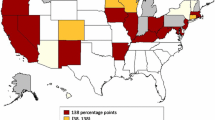Abstract
In this study, we examine differences by firm size in the availability of dependent coverage and the incremental cost of such coverage. We use data from the Medical Expenditure Panel Survey - Insurance Component (MEPS-IC) to show that among employees eligible for single coverage, dependent coverage was almost always available for employees in large firms (100 or more employees) but not in smaller firms, particularly those with fewer than 10 employees. In addition, when dependent coverage was available, eligible employees in smaller firms were more likely than employees in large firms to face two situations that represented the extremes of the incremental cost distribution: (1) they paid nothing for single or family coverage or (2) they paid nothing for single coverage but faced a high contribution for family coverage. These results suggest that firm size may be an important factor in policy assessments, such as analyses of the financial implications for families excluded from subsidized Marketplace coverage due to affordable offers of single coverage or of potential rollbacks to public coverage for children.
Similar content being viewed by others
Notes
The joint distribution of single and employee-plus-one premium contributions is very similar to that for single and family coverage (with lower dollar amounts).
We do not consider changes in expected out-of-pocket spending.
In Medicaid expansion states, individuals with MAGI between 138 and 400% of FPL are eligible for Marketplace subsidies, while in non-expansion states the income range is 100–400% of FPL. It is likely that most of these would not be eligible for Marketplace subsidies since they would have an affordable offer of ESI.
While for ease of exposition we have combined employers with 10–24 employees with those with 25–49 employees, there were differences within this combined category. In particular, in firms with 10–24 employees, 6.1% of eligible employees did not have an offer of dependent coverage compared to 1.4% of eligible employees in firms with 25 to 49 employees.
See for example, Vistnes et al. (2012).
The joint distribution is presented as a matrix, where the first row (column) represents zero contributions for single (family) coverage and the remaining rows (columns) represent the quartiles of positive premium contributions for single (family) coverage. The estimates in the cells represent the percentage of eligible employees at each point in the joint distribution.
Zawacki and Taylor (2005) https://ideas.repec.org/p/cen/wpaper/05-27.html. Also, data on the prevalence of zero contributions for coverage at small employers has been available from the MEPS-IC and from the Kaiser/HRET Survey of Employer-Sponsored Health Benefits.
To develop a standard metric to use across firms of different sizes, the thresholds for the quartiles in the matrix were estimated across eligible employees at the national level, after restricting the sample to eligible employees facing positive employee contributions for single or for family coverage.
References
Buettgens, M., Dubay, L., & Kenney, G. M. (2016). Marketplace subsidies: Changing the ‘family glitch’ reduces family health spending but increases government costs. Health Affairs (Millwood), 35, 1167–1175.
Selden, T. M., Dubay, L., Miller, G. E., Vistnes, J., Buettgens, M., & Kenney, G. M. (2015). Many families may face sharply higher costs if public health insurance for their children is rolled back. Health Affairs (Millwood), 34, 4697–4706.
Vistnes, J., Zawacki, A., Simon, K., & Taylor, A. (2012). Declines in employer-sponsored insurance: Examining the components of coverage by firm size. Health Services Research, 47(3pt1), 919–938.
Zawacki, A., & Taylor, A. (2005). Contributions to health insurance premiums: When does the employer pay 100 percent? U.S. Bureau of the Census, Center for Economic Studies Working Paper 05–27. https://ideas.repec.org/p/cen/wpaper/05-27.html.
Author information
Authors and Affiliations
Corresponding author
Additional information
Disclaimer: The research in this paper was conducted while Edward Miller and Jessica Vistnes were also Census Bureau research associates at the Center for Economic Studies. The views expressed in this paper are those of the authors, and no official endorsement by the Agency for Healthcare Research and Quality or the U.S. Department of Health and Human Services is intended or should be inferred, nor do they necessarily indicate concurrence by the Census Bureau. The results in this paper have been screened to ensure that no confidential information has been revealed. Matthew Buettgens and Lisa Dubay received funding from the National Institute for Health Care Reform and the Urban Institute.
Rights and permissions
About this article
Cite this article
Miller, G.E., Vistnes, J., Buettgens, M. et al. The availability and marginal costs of dependent employer-sponsored health insurance. Int J Health Econ Manag. 17, 251–260 (2017). https://doi.org/10.1007/s10754-016-9210-8
Received:
Accepted:
Published:
Issue Date:
DOI: https://doi.org/10.1007/s10754-016-9210-8



